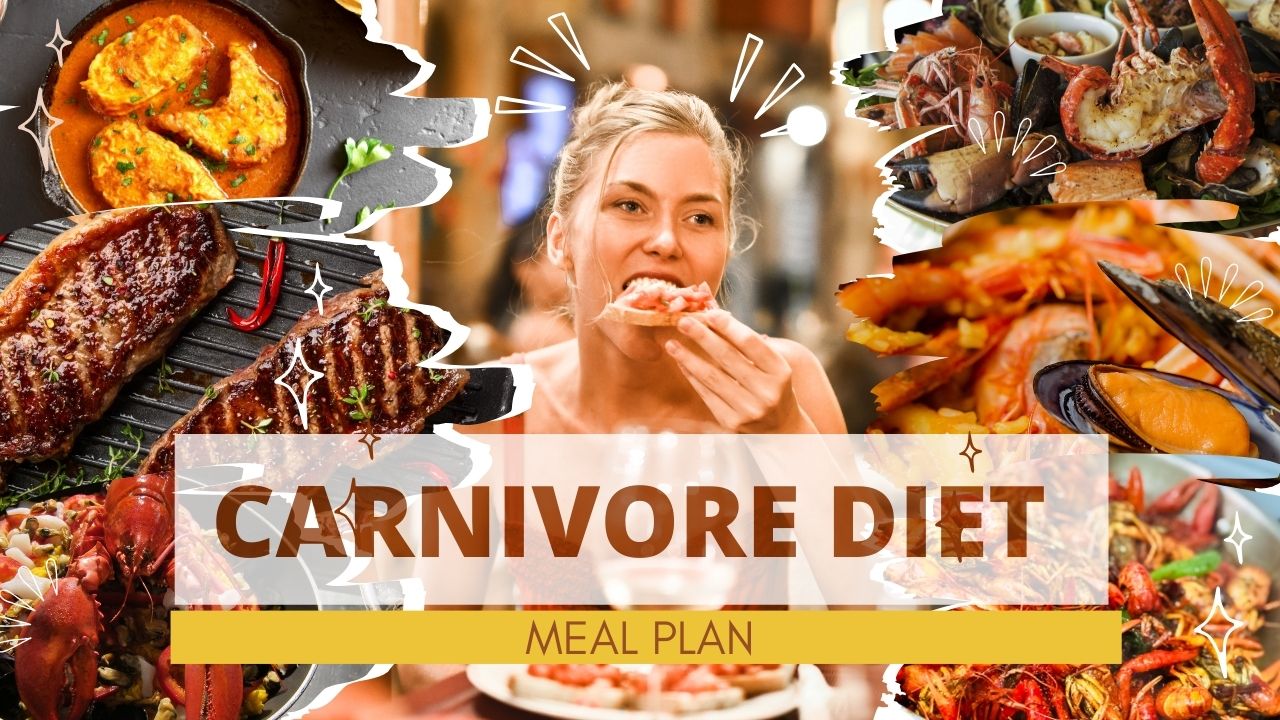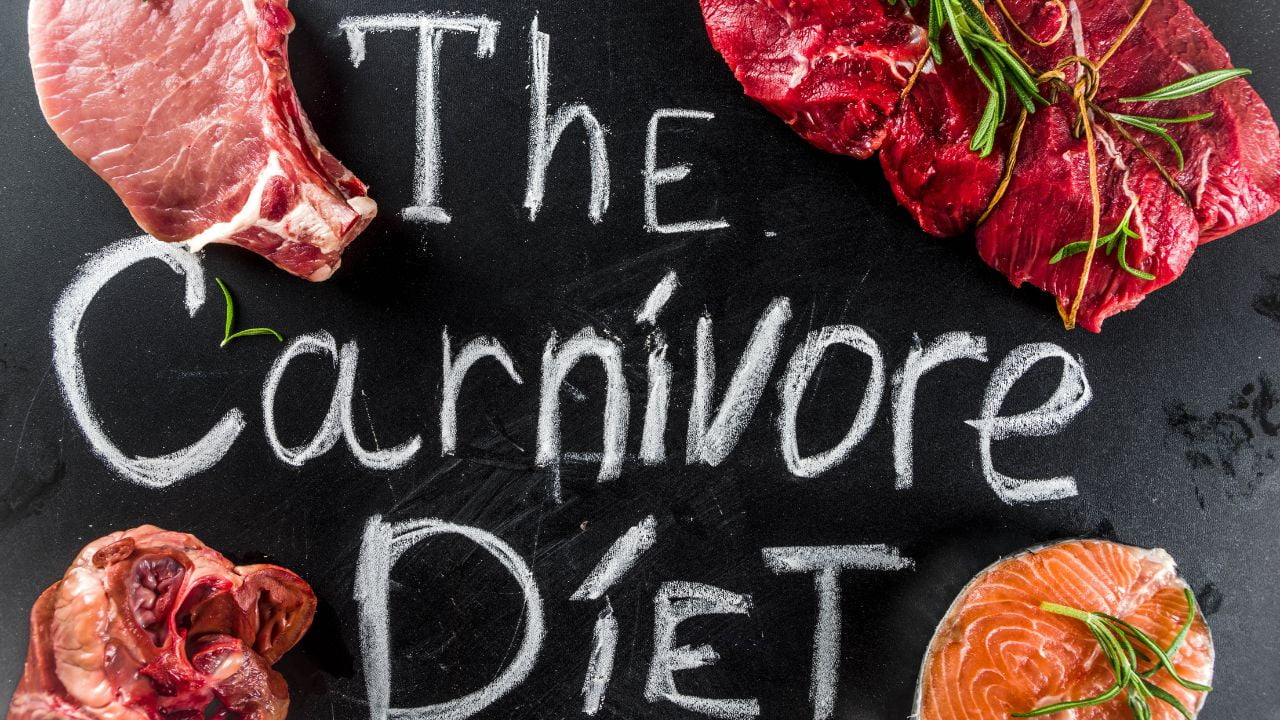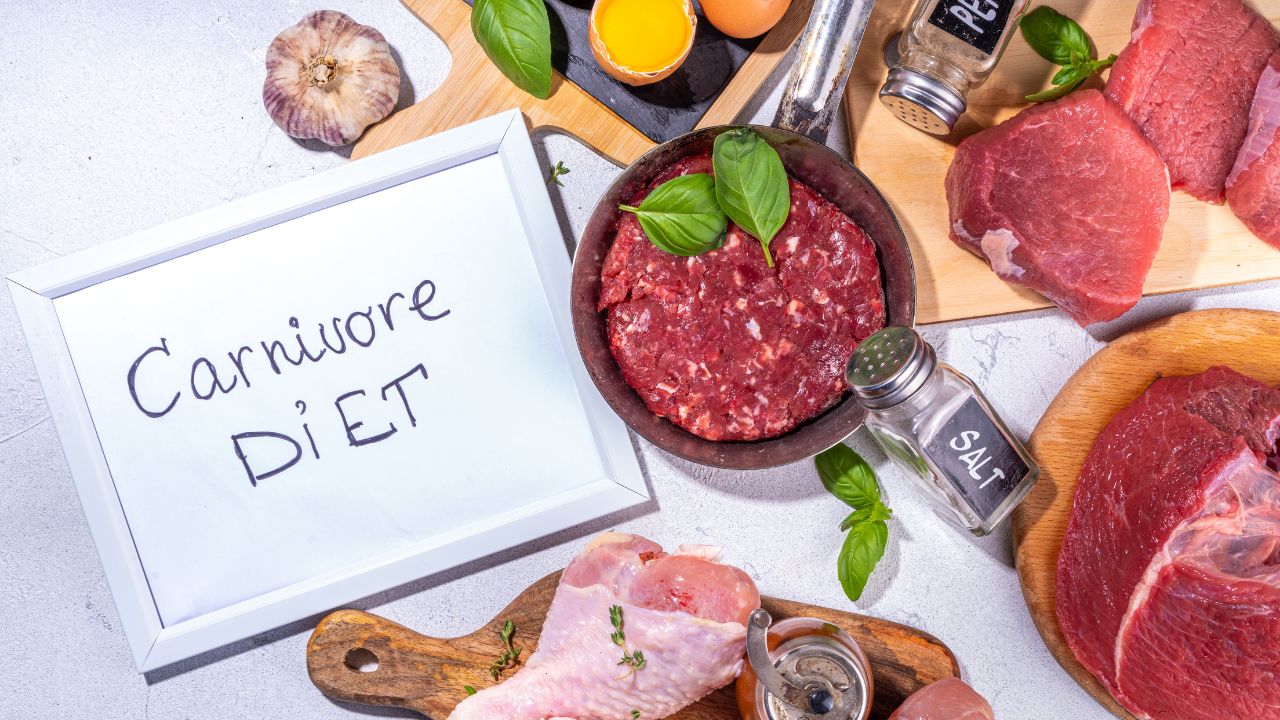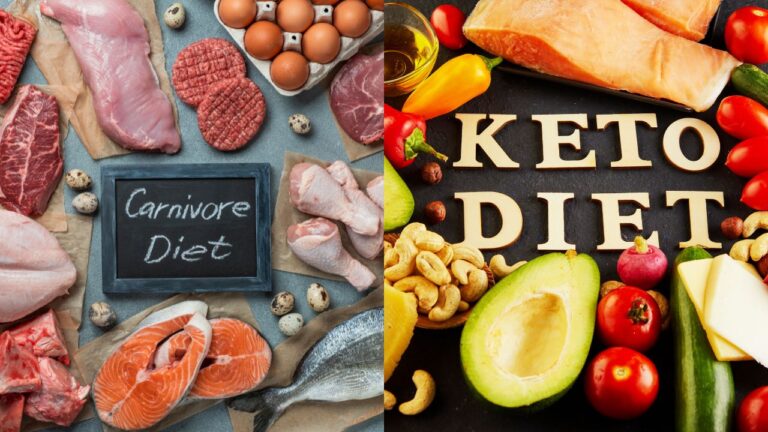Carnivore Diet Meal Plan with Animal-Based Nutrition

The carnivore diet meal plan stands out as a daring and distinctive approach to nutrition in a society overrun with dietary fads and trends. This diet, which has its roots in the way people used to eat, focuses solely on eating animal products. This in-depth manual will explain the nuances of the carnivore diet meal plan and give you a useful meal plan to get you started on the road to a leaner, healthier lifestyle.
Benefits and Principles
The fundamentals of the Carnivore diet meal plan
The carnivore diet is simple in its heart; it calls for the sole consumption of foods made from animals while fully shunning any foods made from plants. This means that meat, fish, and other foods produced from animals will be the main foods you feed your body.
The advantages of a carnivore diet meal plan
Why would somebody opt for such a radical eating approach? Well, this novel technique has attracted people for several plausible reasons:
- Weight Loss: As their bodies adjust to this high-protein, low-carbohydrate diet, many devotees of the carnivore diet report experiencing significant weight loss.
- Mental Clarity: Some advocates of the diet assert that it enhances mental clarity and attention, assisting them in remaining alert all day.
- Reduced Inflammation: The carnivore diet’s absence of typical inflammatory foods including grains and vegetables may provide relief for those who battle chronic inflammation.
The Function of a Well-Designed Meal Plan
The carnivore diet may seem straightforward—just eat meat, right?—but it’s important to realize that success on this nutritional path frequently depends on careful preparation. A well-organized meal plan can help with that.
A careless approach to the carnivorous diet can result in nutritional imbalances, deficiency, and a generally less pleasurable experience. We want to make sure you go into this culinary adventure with a thoroughly thought-out food plan that promotes your health and well-being.
We’ll walk you through the nuances of the carnivore diet meal plan in this blog post, from explaining its tenets to giving you suggestions for breakfast, lunch, and dinner that fit this unusual eating style. So buckle up and prepare to delve into the world of carnivore eating!

Understanding the Carnivore Diet Meal Plan
Examine the Carnivore Diet’s Origins and History.
It’s crucial to explore the historical origins and roots of the carnivorous diet to fully understand it. The idea of an all-meat diet has been around for millennia, even though it may appear like a recent dietary fad.
The traditions of numerous indigenous civilizations serve as the foundation for the carnivorous diet. People may survive without plant-based meals, as evidenced by the Inuit people of the Arctic, who have relied exclusively on a diet of fish and meat. Advocates like Dr. Shawn Baker and Dr. Paul Saladino, who have championed the diet’s potential health benefits, have helped it gain popularity more recently.
Explain the Diet’s Scientific Basis
But is this rather severe eating style supported by science? The science supporting the carnivore diet is both fascinating and debatable.
The diet’s proponents contend that for millions of years, our ancestors subsisted and flourished on a diet largely composed of meat. They emphasize the high nutritional value of animal products, which are a great source of vital vitamins, minerals, and amino acids.
Nevertheless, detractors express worries about possible vitamin deficits and the long-term effects on the health of avoiding plant-based diets, which are high in fiber, antioxidants, and other advantageous substances.
This section will examine the scientific justifications for and against the carnivore diet to give you a fair knowledge of the guiding ideas.
Address Typical Myths and Concerns
The carnivore diet meal plan has its fair share of myths and worries, just like any other dietary fad. When deciding whether or not this eating style is suitable for you, it’s critical to distinguish fact from myth.
Common misunderstandings include the idea that omitting plant foods will cause you to lose out on essential nutrients or that it’s a diet that only emphasizes red meat. To assist you in making wise decisions, we’ll dispel these beliefs and offer evidence-based facts.
The environmental effects of a carnivore diet meal plan and ethical issues related to animal care are also important subjects to research. Even though the diet is primarily concerned with one’s health, these more general issues should not be disregarded.
We’ll examine these myths and worries in this section so that you have a thorough awareness of the complexities and potential difficulties of the carnivorous diet.
Getting Started with the Carnivore Diet Meal Plan
Consultation with a Medical Expert
It’s imperative to speak with a healthcare professional, such as a doctor or certified dietitian, before making any major dietary changes. This first action is essential for several reasons:
- Personal Health Assessment: Your doctor can evaluate your present health, including any underlying illnesses or dietary limitations that might make it more difficult for you to properly maintain a carnivore diet meal plan.
- They can offer advice on how to make the move to a carnivorous diet, assuring a smooth and healthy adaption.
- Regular check-ins with your healthcare provider will help you track your progress and handle any worries that may come up when you adopt a carnivorous diet.
Organizing Your Pantry
It’s time to set up your kitchen for the carnivore diet after getting the all-clear from your doctor. This entails purging your refrigerator and cupboard of any goods that go against the tenets of the diet.
- Eliminating Carbohydrates: Get rid of all grains, fruits, vegetables, and other foods that are high in carbohydrates. This action will help you avoid temptation and guarantee that you stay on course.
- Reading Labels: When purchasing processed goods, make sure to carefully read the labels to find any hidden sources of carbs or additives. Having a firm grasp of what you may and cannot eat is crucial.
- Stocking Up on Animal Products: In place of the goods that were thrown out, replace them with a variety of foods derived from animals, such as different types of meat, poultry, fish, eggs, and dairy products (if you can tolerate them).
Buying Carnivore-Friendly Foods at the Grocery Store
Once you know what to look for, grocery shopping for a carnivore diet can be a fascinating journey. An example of a carnivore-friendly shopping list is shown below:
- Select high-quality meats, ideally those that have been pasture-raised or grass-fed. Take into account a range of cuts, including beef, pig, lamb, and poultry.
- Include fatty fish such as salmon and mackerel since they are rich in omega-3 fatty acids.
- Don’t forget about organ meats like liver, which are rich in vital nutrients.
- Eggs: An adaptable source of protein and good fats, eggs are.
- Dairy (if tolerated): Some people who follow a carnivorous diet consume dairy foods such as heavy cream and cheese. See whether these are effective for you.
- While the diet is predominantly animal-based, spices and seasonings can give your dishes more variety and flavor. Just be sure they don’t have any additives or hidden carbohydrates.
By following these instructions, you’ll have a well-organized kitchen and a clear plan for locating the correct ingredients when you’re ready to start your carnivore diet meal plan journey.
Building Your Carnivore Plate
Place a focus on the three main food groups—meat, fish, and animal products
The cornerstone of the carnivore diet meal plan is straightforward but crucial: make meat, fish, and goods derived from animals the mainstays of your meals.
- Meat: The main component of your carnivore meal should be meat, such as beef, hog, and lamb. These are a good source of protein and important vitamins and minerals including iron.
- Fish: Include oily fish like salmon and mackerel because they contain omega-3 fatty acids, which are essential for the functioning of the heart and brain.
- Animal goods: If tolerated, add additional animal-derived goods like dairy and eggs. These can diversify your diet while supplying essential nutrients.
Describe the Value of Organic and Grass-Fed Sources.
Give preference to grass-fed and organic sources whenever possible when choosing your meat and animal products. This is why:
- Nutritional Value: When compared to meats raised conventionally, grass-fed meats often include higher levels of omega-3 fatty acids and a better ratio of beneficial fats.
- Reduced Toxins: Since organic meats are grown without the use of artificial hormones or antibiotics, there is a lower risk of exposure to these toxins.
- Ethics: Choosing grass-fed and organic products can be in line with moral considerations for the welfare of animals and environmentally friendly farming methods.
Provide guidelines for daily calorie intake and serving sizes
To make sure you’re eating enough food while following a carnivore diet meal plan, you must use the right portion sizes. Remember that each person’s needs may differ depending on their age, gender, and level of exercise. The following are some general principles:
- Protein: Aim for 4-6 ounces (around the size of your palm) of meat or fish per meal. Adapt depending on how hungry and how energetic you are.
- Include fat sources like fatty meat cuts, butter, or tallow in your diet to meet your energy requirements. Starting with one or two tablespoons of extra fat per meal is possible.
- Organ Meats: Due to their high nutrient density, consume organ meats like liver in moderation, perhaps once or twice a week.
- Dairy and eggs (if tolerated): Moderate consumption of dairy and eggs is generally advised. A good place to start is with two to three eggs every meal or a small amount of dairy.
It’s important to pay attention to your body’s signals of hunger and fullness. Portion sizes are flexible on the carnivore diet meal plan, so customize it to suit your needs and interests. You can design a well-balanced carnivore dish that satisfies your nutritional needs and takes advantage of this special dietary strategy by following these rules.
Meal Planning for Success
Advice for Weekly Meal Planning
A successful carnivore diet meal plan journey hinges on effective meal planning. The following are some crucial pointers to guide you through your weekly food planning:
- Variety is Important: While animal products make up a large portion of the carnivore diet, try to be as diverse in your selections as possible. To keep your meals interesting, try experimenting with various meat, fish, and animal-derived dishes.
- It’s Critical to Prepare: Plan and prepare your meals ahead of time, especially if your calendar is busy. Having solutions that are suitable for carnivores close at hand can keep you on track.
- Include Organ Meats: Keep liver and other nutrient-dense organ meats in your regular meal rotation. To make them more appetizing, combine them with other meats.
Think about Intermittent Fasting: Some ardent carnivores use intermittent fasting in their daily meal regimens. This can entail eating only at a certain window of time each day or going long stretches without eating. Before attempting to fast, especially if you have underlying medical concerns, speak with a healthcare expert.
Beginners’ Sample Meal Schedules
Here are some sample meal plans to get you started if you’re new to the carnivore diet:
Meal Schedule 1: Three Meals a Day
- Breakfast: eggs and steak
- Grilled fish with butter for lunch.
- Dinner will be bacon-wrapped pork chops.
Meal Schedule 2: Two Meals a Day (Intermittent Fasting)
- Meal 1: Ribeye steak with scrambled eggs on the side (about midday).
- Meal 2: Around 6:00 p.m. buttery chicken thighs
Meal Schedule 3: One Meal a Day (OMAD)
- Dinner will include a sizable portion of prime rib and a side of liver.
Please feel free to change these times to fit your tastes and daily schedule. Fewer meals are preferred by some people, whereas more frequent meals are preferred by others.
Keeping Macronutrients and Micronutrients in Balance
On the carnivore diet, it is crucial to balance macronutrients (protein, fats, and carbohydrates) and make sure you’re getting enough micronutrients:
- Make protein the main component of all of your meals. It is essential for maintaining muscles and maintaining general body health.
- Include enough wholesome fats in your diet to suit your energy needs. The long-lasting energy that fats offer can help you feel full between meals.
- Limit your intake of carbohydrates strictly to almost none, as this is a key component of the carnivorous diet.
- Micronutrients: If you need to supplement your diet with additional magnesium, vitamin D, or potassium, do so. Adding organ meats and changing up your meat selection can also aid in offering important vitamins and minerals.
You can determine if you’re eating a balanced diet by keeping an eye on your general health and even having regular blood work done. You can then address any deficiencies that may emerge.
You may start your carnivore diet journey with confidence and position yourself for long-term success by using these meal planning advice and sample schedules.
Breakfast Ideas for Carnivore Diet Meal Plan
Breakfast Items Packed With Protein
On the carnivore diet, breakfast has the potential to be a satisfying and nourishing meal. It is frequently regarded as the most significant meal of the day. Here are some possibilities for a protein-rich breakfast to get your day started:
- sirloin & Eggs is a traditional breakfast for carnivores that mixes a tender sirloin with fried or scrambled eggs for a substantial protein boost.
- Crispy bacon and flavorful sausages are two delectable options that are quick and simple to prepare.
- Salmon and Cream Cheese: Smoked salmon and cream cheese provide a delicious and filling breakfast alternative that is high in good fats.
- Omelette: Make an omelet that is suitable for carnivores by stuffing it with meat, cheese, and other animal-derived ingredients.
- Ground Meat Scramble: For a flavorful and filling scramble, cook ground beef or pork with eggs and spices.
Talk about the Carnivore Diet and coffee and tea
Due to their plant roots, coffee and tea might be controversial when it comes to the carnivorous diet. However, many carnivore enthusiasts decide to incorporate these drinks into their everyday schedules.
- Coffee: On a carnivorous diet, black coffee is typically regarded as acceptable. It has a small amount of carbohydrate content but delivers caffeine for a boost in alertness. However, keep in mind that certain people may be sensitive to how caffeine affects their bodies.
- Tea: Carnivore diets frequently include herbal teas that don’t contain components from plants. Examples are teas made with bone broth or peppermint tea.
Meal planning ideas and recipes
To improve your breakfast, try these carnivore-friendly recipes and meal prep ideas:
- Breakfast muffins for carnivores can be made with ground meat, eggs, and spices. You may prepare these in bulk for quick breakfasts on the run.
- Egg Cups: For a portable and protein-rich breakfast alternative, bake eggs in muffin tins with your choice of cheese and meat.
- Warm, nourishing bone broth can be a calming way to start the day. For added flavor, you can add salt, pepper, or spices.
- Carnivore Smoothie: For a nutrient-rich morning shake, blend raw or frozen animal-derived ingredients like beef suet or raw egg yolks with water or bone broth.
- Sous Vide Steak: Using a sous vide device, you may cook a steak to the precise doneness you want. Steak for breakfast is a delicious and practical option.
Keep in mind to modify ingredients and portion amounts according to your dietary requirements and tastes. By following the guidelines of the carnivorous diet, you may start your day off well with these breakfast suggestions and recipes.

Lunch and Dinner Options
A Wide Range of Meat and Fish Options
The variety that the carnivore diet offers within its few food groups is one of its benefits. Plan your lunch and supper meals with these ideas in mind for variety and flavor:
- Enjoy different meat cuts like ribeye, sirloin, or ground beef. Every cut delivers a different flavor and texture.
- Poultry: Whether you want skinless breasts, thighs, or full-roasted birds, chicken and turkey can be delectable options.
- Pork: Enjoy chops, roasts, or sausages to showcase the diversity of pork.
- Lamb: Lamb mixes nicely with herbs and spices because of its strong flavor.
- Salmon, mackerel, or sardines are good sources of omega-3 fatty acids and have a delicious flavor.
- Shellfish: For a seafood twist on your carnivore diet, think about including shrimp, crab, or lobster.
Including organ meats and other products derived from animals
To guarantee a well-rounded nutritional profile, don’t forget to incorporate organ meats and other animal-based products:
- Liver: Packed with vitamins and minerals, the liver is a nutritious powerhouse. Try it sautéed or pâté-styled.
- Bone broth: Enjoy a warm, comforting beverage made from bone broth, which is rich in nutrients.
- If you can tolerate dairy, you should include cheese or heavy cream for taste and diversity.
- Eggs: Eggs are a flexible addition that may be used for both lunch and dinner. Enjoy them fried, poached, or scrambled.
- Tallow and lard are two excellent animal-based fats for cooking and flavoring food.
Recipes that are delicious for carnivores
Check out these recipes that are suitable for carnivores to make your lunch and dinner genuinely delicious:
- Hollow out bell peppers and fill them with minced beef, cheese, herbs, and seasonings for a filling supper.
- Stir-fry for carnivores: Slice meat thinly and stir-fry with seasonings and animal fats. If you can tolerate them, add some low-carb vegetables like bell peppers or zucchini.
- Grilled salmon fillets are topped with a delicious herb butter that is created from animal fats.
- Large lettuce leaves can be used as taco shells for Carnivore Tacos, which are then filled with flavorful ground meat, cheese, and sour cream.
- Chicken thighs can be roasted with your preferred seasonings for a dinner that is crispy and tasty.
- Beef and Liver Stew: For a nutrient-packed stew, combine beef chunks and liver and boil in a thick broth.
These dishes can spice up your carnivorous diet and guarantee that you’re getting the nourishment you need. You are welcome to adjust and change them to suit your personal preferences.
Snacks and Side Dishes of Carnivore Diet Meal Plan
Discuss the Carnivore Diet Meal Plan’s Limited Snacking Options
Due to the emphasis on large, nutrient-dense meals, snacking is typically minimized on the carnivore diet. However, if you find yourself craving a snack or have certain nutritional needs, take into account the following:
- Limiting Snacking: The carnivore diet promotes filling up at meals, which should ideally keep you satiated in between them and minimize the need for snacks.
- Fasting Periods: Some carnivorous practitioners engage in intermittent fasting, which involves setting aside specific times when they don’t eat. No refreshments are eaten during these fasting hours.
- Occasionally Snacking: If you feel the urge to snack, choose something small and protein-rich, like cheese or jerky. These can assist with maintaining your energy levels while abiding by carnivorous principles.
Look into Side Dishes That Fit the Diet
Compared to other diets, the carnivore diet has fewer side dishes, but there are still several choices that go well with your primary sources of protein:
- Animal Fats: Use animal fats, such as tallow or lard, as condiments or cooking ingredients. These add additional taste and good fats.
- Bone broth: To provide variety and supply necessary nutrients, a warm cup of bone broth can be served as a side dish.
- Fermented Foods: Because they may aid in digestion, some carnivores serve fermented foods as a side dish, such as sauerkraut or kimchi.
- Simple salads with components like lettuce or spinach and animal-based dressings (such as rendered bacon fat) can be an option if you can stomach them.
Present Innovative Snack Concepts
Although the carnivore diet does not emphasize snacking, here are some inventive snack suggestions for those times when you feel like a quick bite:
- Whenever possible, choose beef jerky that is of the highest quality, is handcrafted, or has undergone the least amount of processing.
- Cheese: Hard cheeses with a low lactose content, such as cheddar or gouda, can make a filling and protein-rich snack.
- When you’re craving something savory, pork rinds make a crunchy alternative that is free of carbohydrates.
- Eggs, hard-boiled: For a quick and protein-rich snack, prepare a batch of eggs in advance.
- Pre-cooked bacon strips are a delicious cold snack that may be stored in the refrigerator.
On the carnivore diet, keep in mind that snacking should be an occasional treat rather than a frequent occurrence. The major emphasis should continue to be on balanced, nutrient-dense meals.
Staying Hydrated with Carnivore Diet Meal Plan
The Value of Regular Water Consumption
On the carnivorous diet, proper water is just as important for general health. This is why it’s so important to drink enough water:
- Healthy digestion requires drinking enough water, which aids in the breakdown of meals and makes it easier for nutrients to be absorbed.
- Water helps your body maintain a healthy temperature, which is crucial if you often consume high-protein diets that produce heat during digestion.
- Dehydration can affect focus and cognitive function, therefore maintaining adequate fluids promotes mental clarity.
- Water helps with detoxification by assisting in the removal of waste items from your body.
Although there isn’t a set daily water intake recommendation for a carnivore diet meal plan, you should try to drink water frequently throughout the day and pay attention to your body’s thirst signals.
Balance and Supplementation of Electrolytes
Due to the lack of electrolyte-rich plant foods when following the carnivore diet meal plan, you might need to pay more attention to your electrolyte balance. Here’s how to keep your electrolyte levels in check:
- Sodium: It’s important to consume enough sodium. Consider adding a pinch of sea salt or Himalayan salt to your water, and season your food to taste.
- While some potassium is present in meat, it’s a good idea to include potassium-rich meals like avocados or, if necessary, take potassium supplements.
- Magnesium: If tolerated, magnesium supplements or foods high in magnesium, such as nuts, can assist in maintaining this vital mineral.
- Calcium: Dairy products can be a source of calcium if they are tolerated. If you don’t eat dairy, you might want to think about calcium supplements or meals.
Be careful of your unique requirements, and if you have questions regarding electrolyte balance or are thinking about taking supplements, speak with a healthcare provider.
Drinks to Steer Clear of on a Carnivore Diet Meal Plan
The types of beverages one can consume are severely limited by the carnivorous diet. Here are some drinks to stay away from:
- Fruit juices: Fruit juices are strong in sugars and carbohydrates, which are in opposition to the carnivore diet’s core values.
- Drinks that are high in sugar and have little nutritional benefit include soda and other sweetened beverages.
- Alcoholic Beverages: The majority of alcoholic beverages contain carbohydrates, and alcohol can have an impact on how you decide what to eat.
- Drinks with artificial sweeteners: These frequently include additives and artificial sweeteners, which may compromise the tenets of the diet.
- Vegetable Juices: Because they are made from plants, even vegetable juices are forbidden on the carnivore diet.
To keep the carnivore diet meal plan pure, stick to water, black coffee, and herbal teas devoid of plant-based additives. Your main beverage should be water to help you stay hydrated while following the rules of the diet.
Monitoring Progress and Adjustments
Monitoring Your Well-Being and Health
Any diet, especially the carnivore diet, requires regular monitoring of your health and well-being. Here’s how to efficiently monitor your development:
- Keep a food notebook to keep track of your daily meals. This can assist in locating any patterns or dietary factors.
- Health, both physical and mental: Pay attention to how you’re feeling. Keep track of any adjustments to your mood, digestion, or other biological systems.
- Measure and keep track of your body’s measurements regularly, including your weight, waist size, and body fat percentage. This can offer insightful information about your development.
Identifying Success Indicators and Improvement Needs
Success on the carnivore diet meal plan can appear in a variety of ways, but it’s vital to keep in mind that every person’s experience will be unique. Watch out for these indications of success:
- Weight management: Track changes in your weight over time if you want to lose weight. A steady fall may be a sign of development.
- Increased Energy: Many people who follow the diet report having more energy and mental clarity.
- Reduced Inflammation: Keep an eye on any symptoms that are caused by inflammation, like joint pain or gastrointestinal discomfort.
- Better Digestion: Some people discover that eating a carnivorous diet helps their digestive health. Keep an eye out for any modifications in bowel habits as well as general gastrointestinal comfort.
- Overall Assess your general feeling of wellbeing, including your mood and sleep hygiene. Success can be determined by positive changes in these areas.
However, keep an eye out for potential improvement areas as well:
- Ensure that you are consuming enough nutrients, and if you need to supplement your diet—especially for micronutrients like vitamins and minerals—consider doing so.
- Digestive Problems: If you have digestive issues, such as constipation or diarrhea, it might be time to change your diet.
- Long-Term Sustainability: Take into account whether the carnivorous diet is compatible with your way of life and your long-term health objectives.
Seeking Advice from a Healthcare Professional
If you have worries about your diet, are experiencing health issues, or have questions about your progress, it is encouraged that you consult a healthcare professional. When should you consider talking to them?
- Concerns about Nutrient Deficiencies: A trained dietician or healthcare professional can offer advice and may suggest supplements if you’re concerned about possible nutrient deficiencies or imbalances in your diet.
- Consistent Health Problems: If you experience ongoing health problems, such as unexplained weight changes or gastrointestinal pain, get medical advice to rule out any underlying medical illnesses.
- Long-Term Planning: If you’re interested in keeping up a carnivore diet meal plan over the long haul, a healthcare professional can assist you in creating a workable plan and keeping track of your health as you go.
It’s important to start your dietary journey with a focus on your individual needs and health goals and to contact professionals as necessary because individual responses to the carnivore diet can vary greatly.
Conclusion of Carnivore Diet Meal Plan
In conclusion, the carnivore diet meal plan offers a distinctive and fascinating method of eating. Adherents of this diet have reported a variety of potential advantages by only consuming animal-based items, including:
- Weight reduction: As people’s bodies adjust to a low-carb, high-protein diet, many people experience weight reduction.
- Improved mental focus and clarity may be a welcome side effect of the carnivorous diet for some people.
- Reduced Inflammation: This diet avoids key inflammatory triggers present in plant-based meals, which may provide relief to those who suffer from chronic inflammation.
Instruct readers to follow the meal plan and pay attention to their bodies.
We recommend that you attempt the suggested meal plan if the carnivorous diet interests you. It’s crucial to pay attention to how you feel and listen to your body when making dietary changes. Be mindful of your mood, digestion, and general well-being as well as your energy levels. Keep in mind that every person may react differently, so what works for one person may not work the same way for someone else.
Offer Extra Support and Resources to Those Interested in the Diet
There are several websites and online forums that can offer direction and support if you’re interested in learning more about the carnivore diet:
- works: To learn more about the tenets of the diet, read works by authorities on the subject like “The Carnivore Code” by Dr. Paul Saladino or “The Carnivore Diet” by Dr. Shawn Baker.
- Join online groups on social media, forums, or communities that focus on the carnivorous diet. These can offer insightful information, advice, and a sense of community.
- Consult a Professional: If you’re thinking about making a big dietary change, speak with a qualified dietician or healthcare provider. They can offer advice on nutrient balance and supplements, as well as help you modify the diet to suit your particular needs.
- The carnivore diet is ultimately not for everyone, therefore it’s important to make educated decisions regarding your eating habits. Prioritize your health and well-being above all else, regardless of whether you decide to accept it entirely or incorporate some of its principles into your current diet.
Remember that your road to a carnivore diet is highly personal and that choosing a strategy that promotes your health and fits with your lifestyle and values is what counts most.
Additional Resources of Carnivore Diet Meal Plan
Suggest books, websites, and online forums
Consider the following resources if you want to learn more about the carnivore diet or if you want further advice and information:
- Books:
- “The Carnivore Code“ by Dr. Paul Saladino
- “The Carnivore Diet“ by Dr. Shawn Baker
- “The Fat of the Land“ by Vilhjalmur Stefansson
- Websites:
- MeatRx: A comprehensive resource with articles, success stories, and a community forum.
- Carnivore Aurelius: Provides in-depth articles and resources about the carnivore diet.
- Online Communities:
- Reddit’s Carnivore Diet Community: An active subreddit where people share experiences, advice, and support.
- Carnivore Tribe on Facebook: A Facebook group dedicated to discussing the carnivore diet.
Suggest Cookbooks and Recipes for Carnivore Enthusiasts
There are a variety of inventive methods to prepare food even though the carnivore diet generally emphasizes whole animal-based items. For those who enjoy eating meat, take a look at these cookbooks and recipe sources:
- “The Carnivore Cookbook” by Maria and Craig Emmerich: This cookbook offers a variety of carnivore-friendly recipes and meal ideas.
- “Carnivore Cooking with Maria” (YouTube Channel): Maria Emmerich’s YouTube channel provides cooking demonstrations and recipe ideas for carnivores.
- Personal Experimentation: Utilize your creativity in the kitchen by experimenting with various meat cuts, cooking techniques, and seasonings. Keep a list of your preferred carnivorous recipes in a diary.
Always keep in mind the fundamentals of the carnivorous diet when browsing cookbooks and recipes. Prioritize nutrient density, emphasize animal-based foods, and steer clear of plant-based additions.
Frequently Asked Questions for Carnivore Diet Meal Plan
What is a Carnivore Diet Meal Plan and what foods can I eat on one?
A diet strategy known as the carnivore diet mostly consists of animal-based meals. You can eat a range of meats (beef, pork, poultry, etc.), fatty fish, organ meats, eggs, and dairy if you can stomach it while following this diet. Plant-based foods like fruits, vegetables, grains, and legumes are prohibited from the diet.
Is a long-term Carnivore Diet Meal Plan safe to follow?
Research and discussion on the long-term safety of the carnivore diet are ongoing. While some people opt to use it as a short-term intervention, others choose to follow it for longer periods. If you intend to stick with the diet for a prolonged period, it’s critical to keep an eye on your health, speak with a healthcare provider, and possibly think about taking supplements to make up for any potential nutrient shortages.
Will the Carnivore Diet Meal Plan provide me with enough nutrients?
While the carnivore diet can include important elements like protein, vitamins, and minerals, it is deficient in key nutrients that are often found in plant-based foods, including fiber and some vitamins (such as vitamin C). It is advised to eat a variety of animal products and, if necessary, to think about supplements to ensure nutrient adequacy. Addressing specific nutritional difficulties might be facilitated by speaking with a healthcare professional or certified dietitian.
Can I have tea or coffee while following the Carnivore Diet Meal Plan?
On the carnivore diet, black coffee and herbal teas without plant-based additives are typically permitted. However, some people could be sensitive to caffeine, so it’s important to pay attention to your body and see how these drinks make you feel. Don’t sweeten your coffee or tea with sugars, artificial sweeteners, or plant-based creamers.
On the Carnivore Diet Meal Plan, is it vital to monitor macronutrient intake?
On the carnivore diet, tracking macronutrients isn’t always necessary, but some people find it useful, particularly when they first start. This can guarantee that the ratio of protein to fat in your diet is optimal. But when you get used to the diet, you could discover that eating intuitively depending on your hunger and energy levels is plenty. It’s crucial to keep an eye on your health indicators and general well-being.






